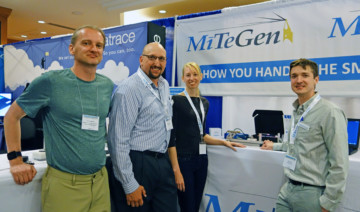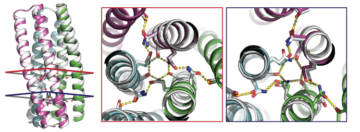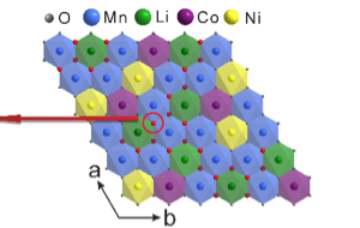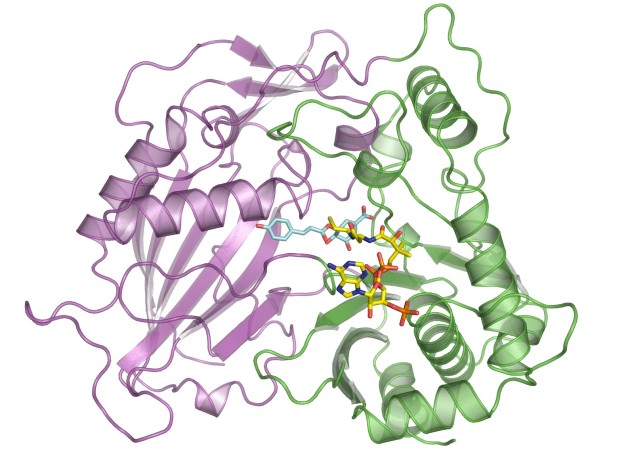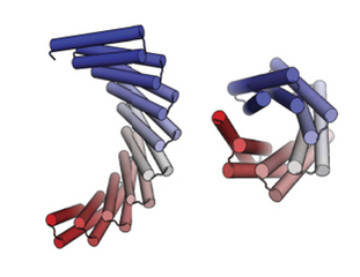A beamstop device recently developed at the ALS has successfully combined two essential crystallographic functions–capturing the damaging portion of the beam while simultaneously monitoring its intensity–into a single miniaturized package. The technology has been licensed and launched commercially and is also a finalist for an R&D 100 Award. Read more »![]()
ALS Work Using Scattering/Diffraction
These techniques make use of the patterns of light produced when x-rays are deflected by the closely spaced lattice of atoms in solids and are commonly used to determine the structures of crystals and large molecules such as proteins.
Improving Alloy Memory by Tuning Material Composition
Shape memory alloys can “remember” their original form and return to it repeatedly when heated. To gain structural insight into a new alloy capable of sustaining millions of cycles without failure, researchers performed x-ray Laue microdiffraction at ALS Beamline 12.3.2. Read more »
Validation of Novel Proteins Inspired by Nature
Designed proteins containing hydrogen-bonding modules have been validated by crystallography and SAXS. The ability to design synthetic molecules that combine the specificity of DNA-like binding with protein function opens up huge opportunities for the fields of synthetic biology and materials science. Read more »
How Antidepressants Block Serotonin Transport
Malfunctions in the complex protein “machinery” of serotonin transport can result in depression, obsessive-compulsive disorder, aggression, anxiety, and Parkinson’s disease. Now, researchers have obtained x-ray crystallographic structures of the difficult-to-crystallize human serotonin transporter bound to two commonly prescribed antidepressant drug molecules. Read more »![]()
![]()
New Insights into Oxygen’s Role in Lithium Battery Capacity
Researchers working at the ALS have recently made new discoveries in understanding the nature of charge storage in lithium-ion (Li-ion) batteries, opening up possibilities for new battery designs with significantly improved capacity. Looking at a popular Li-rich cathode material, the researchers used soft x-ray techniques to quantifiably explain oxygen’s role in Li-ion charge capacity. Read more »![]()
![]()
Understanding the Key to Henipavirus Infection
The Hendra virus was the first member of the genus Henipavirus, an emergent group of viruses with a high mortality rate. Knowledge of the protein structure that mediates Hendra entry into host cells could enable the design of antigens with improved immunogenic response. Read more »
3D Charge Order Found in Superconductor
Resonant soft x-ray diffraction studies of a cuprate high-temperature superconductor revealed a 3D, long-range charge order—the first of its kind ever reported in a cuprate—that competes with superconductivity. A better understanding of such phenomena could help in the design of more robust superconductors with higher transition temperatures. Read more »![]()
![]()
Reducing Plant Lignin for Cheaper Biofuels
Scientists have identified and validated a novel approach to reducing lignin in plants by tweaking a key lignin enzyme. Their technique could help lower the cost of converting biomass into carbon-neutral fuels to power cars and other sustainably developed bio-products. Read more »![]()
Shutting Out Ebola and Other Viruses
Researchers have used protein crystallography at the ALS to understand how a drug molecule that has shown some efficacy against Ebola in mice inactivates a membrane protein, called TPC1, used by viruses to infect host cells. Read more »![]()
![]()
Exploring the Repeat-Protein Universe
Researchers have published a landmark study that used both crystallography and SAXS to validate computationally designed structures of novel proteins with repeated motifs. The results show that the protein-folding universe is far larger than realized, opening up a wide array of new possibilities for biomolecular engineering. Read more »![]()
![]()
- « Previous Page
- 1
- …
- 32
- 33
- 34
- 35
- 36
- …
- 39
- Next Page »
